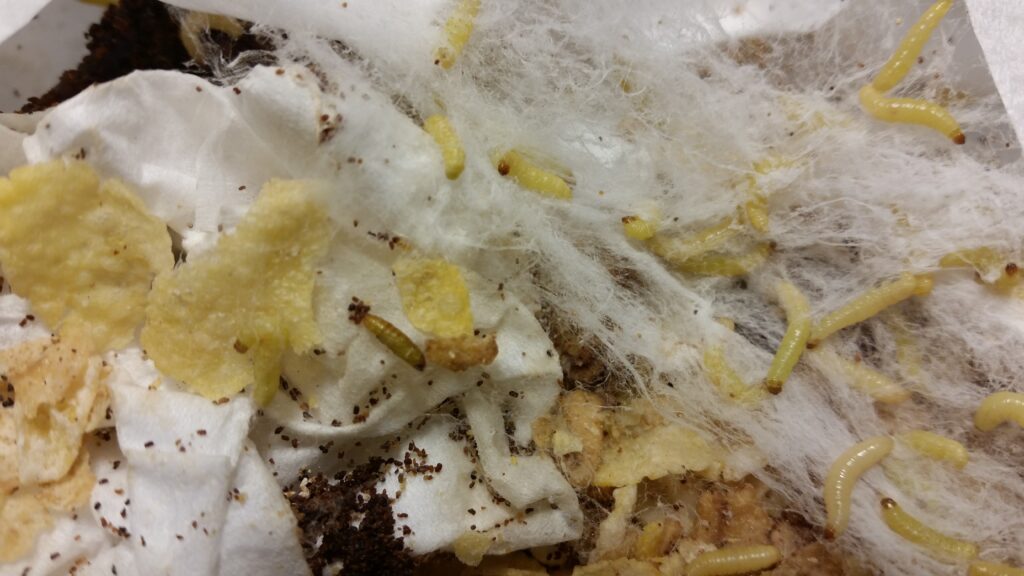Everything about Pantry Moths
| Everything About Pantry Moths | |
|---|---|
| Feature | Description |
| Size | Adult moths are about 8-10 mm in length with a wingspan of about 16-20 mm. |
| Color | Their wings are gray at the base and reddish-brown with a coppery sheen on the outer two-thirds. |
| Larvae Appearance | The larvae are off-white with brown heads and can be up to 12 mm long. |
| Diet | Feed on grains, flours, dried fruits, nuts, chocolates, candies, pet food, and other dry food products. |
| Lifecycle | Females lay eggs on food sources. Larvae feed until ready to pupate, often migrating to pupate in cracks or crevices. |
| Signs of Infestation | Webbing in food, clumps in grains, small moths flying, especially in kitchens or where food is stored. |
| Prevention & Management | Regularly inspect food, keep pantry items in sealed containers, clean food spills promptly, and discard infested items. |
Dissecting Moths Anatomy
Moths, along with butterflies, belong to the order Lepidoptera. They are well-known for their nocturnal habits and their attraction to light. Moths vary greatly in size and coloration, but their basic anatomy is consistent across species. Here’s a breakdown of a moth’s anatomy:
Head
Thorax
Abdomen
Internal Systems
Life Cycle Stages
Head
- Antennae: Moths have a pair of antennae that are usually feathery or filamentous. They serve as primary sensory organs, especially for detecting pheromones released by potential mates. The shape and structure of the antennae can vary between species and can be a useful identification feature.
- Compound Eyes: Moths have large compound eyes that are adapted for low-light vision. Some moths may also have simple eyes, or ocelli.
- Proboscis: This is a long, coiled tube that the moth uses to feed on nectar from flowers. Some species of moths don’t feed as adults and therefore have reduced or non-functional proboscises.
- Palps: These are sensory structures located near the mouth that assist in the detection of chemical cues from the environment.
Thorax
- Wings: Moths typically have two pairs of wings covered in tiny scales, which give them their diverse colors and patterns. These scales can rub off easily, leaving a powdery residue. The arrangement and pattern of these scales can help in species identification.
- Legs: Moths have three pairs of legs attached to the thorax. The legs are often covered in scales and may have spines or other structures that help in gripping surfaces.
- Hearing Organs: Some moths possess tympanic organs that serve as ears. These organs can detect the ultrasonic calls of predatory bats, allowing the moth to take evasive action.
Abdomen
- Segments: The abdomen is segmented and contains the majority of the moth’s internal organs, including those for digestion and reproduction.
- Spiracles: These small openings along the sides of the abdomen are part of the moth’s respiratory system, allowing for the exchange of gases.
- Genitalia: The structure of the male and female genitalia can be quite intricate and species-specific. They are often used in scientific taxonomy to differentiate between closely related species.
- Pheromone Glands: Typically found in females, these glands produce chemical signals that attract males for mating.
Internal Systems
- Digestive System: Adult moths that feed have a digestive system adapted to process nectar. In species that don’t feed as adults, the digestive system may be reduced.
- Reproductive System: Female moths lay eggs after mating, and the structure and appearance of the eggs can vary by species. The reproductive organs in males and females are adapted for species-specific mating.
- Respiratory System: Moths respire through a system of tubes, called tracheae, which connect to the external environment through the spiracles.
- Circulatory System: Moths, like other insects, have an open circulatory system. Their “blood” (called hemolymph) is pumped by a dorsal heart and bathes the internal organs directly.
- Nervous System: Moths have a brain, ventral nerve cord, and associated ganglia.
Life Cycle Stages
- Eggs: The initial stage of the life cycle, laid by females on suitable host plants or other substrates.
- Larvae (Caterpillars): The primary feeding stage, which eventually pupates after a series of molts.
- Pupa: A transitional stage where the larva undergoes metamorphosis to become an adult.
- Adult: The reproductive stage, which might feed on nectar or not feed at all, depending on the species.
How Do I Get Rid Of Moths?
Managing moth infestations requires a combination of prevention and targeted treatments. By employing Moth Control & Treatment techniques, such as pheromone traps and insecticides, you can effectively address the problem.
Regular cleaning, vacuuming, and properly storing clothes and pantry items can help deter moths. For larger infestations, it’s best to seek professionals adept in Moth Removal for a thorough solution.
What are the most common types of Moths in Canada?
Pantry moths, also known as Indian meal moths, are common household pests that are often found in kitchens and pantries, feeding on grains, flour, dried fruits, and other stored food products. Here are some characteristics of the pantry moth:
- Pantry moth (Plodia interpunctella)

Call us for a Free Moth Inspection
What are the characteristics of Pantry Moths?

| Characteristics of Pantry Moths | |
|---|---|
| Feature | Description |
| Size | Adult moths are about 8-10 mm in length with a wingspan of about 16-20 mm. |
| Color | Their wings are gray at the base and reddish-brown with a coppery sheen on the outer two-thirds. |
| Shape | Small, slender-bodied moth with wing patterns distinguishing them from other household moths. |
| Larvae Appearance | The larvae are off-white with brown heads and can be up to 12 mm long. |
| Habitat | Primarily found in pantries, kitchens, or where dry foods are stored. |
| Diet | Feed on grains, flours, dried fruits, nuts, chocolates, candies, pet food, and other dry food products. |
| Reproduction | Females lay eggs on food sources. Larvae feed until ready to pupate, often migrating to pupate in cracks or crevices. |
Call us for a Free Moth Inspection
Top Tips To Prevent Moths Infestations: Essential Guide
- Regular Cleaning:
Clothes: Before storing clothes, especially woolens and silks, ensure they are clean. Moths are particularly attracted to clothes with food stains or sweat.
Pantry: Clean pantry shelves regularly and vacuum cracks and crevices where moths might lay eggs.
- Store Food and Clothes Properly:
Food: Store grains, cereals, and other pantry items in airtight containers. This not only prevents moths from accessing the food but also traps any larvae that might already be inside.
Clothes: Use garment bags, especially for seasonal clothes. Sealed plastic containers can also be effective.
- Natural Repellents:
Cedar: Moths dislike the smell of cedar. Using cedar hangers or placing cedar balls in closets can be effective. However, remember that cedar loses its scent and effectiveness over time, so it needs to be replaced or refreshed.
Herbs: Place sachets of dried herbs such as lavender, rosemary, or mint in closets and drawers. They act as natural moth repellents.
- Monitor and Trap:
Use pheromone traps to monitor and catch male moths. These traps contain a scent that attracts male moths, preventing them from mating with females. While they won’t eliminate an infestation, they’ll give you an indication of the severity of the problem and reduce the breeding population.
- Control Humidity:
Moths thrive in humid conditions. Using dehumidifiers or silica gel packets in areas prone to moisture can deter moths from settling and breeding.
Frequently Asked Questions about Moths
Adult moths typically feed on nectar from flowers, but some species don’t feed at all once they reach adulthood. The larvae, or caterpillars, consume a variety of foods depending on the species, including wool, silk, grains, and even other insects.
The exact reason isn’t fully understood, but a leading theory is that moths use natural light sources, such as the moon or stars, for navigation. Artificial lights disorient them, causing them to fly in spirals or loops around the source.
Most moths are harmless and don’t bite or sting. However, some moth caterpillars do have hairs or spines that can irritate the skin if touched. Additionally, certain species, like clothes moths and pantry moths, can be pests as they damage fabrics or contaminate food.
